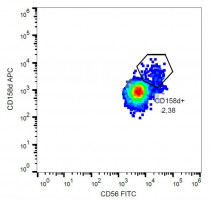ARG54265
anti-CD158d / KIR2DL4 antibody [mAb#33] (APC)
anti-CD158d / KIR2DL4 antibody [mAb#33] (APC) for Flow cytometry and Human
Immune System antibody
Overview
| Product Description | APC-conjugated Mouse Monoclonal antibody [mAb#33] recognizes CD158d / KIR2DL4 |
|---|---|
| Tested Reactivity | Hu |
| Tested Application | FACS |
| Specificity | The clone mAb 33 (also known as mAb 33 or 33) recognizes extracellular portion of CD158d / KIR2DL4, a 45 kDa NK cell marker. Cell surface expression and function of CD158d / KIR2DL4 depends on genotype of particular individuals. |
| Host | Mouse |
| Clonality | Monoclonal |
| Clone | mAb#33 |
| Isotype | IgG1 |
| Target Name | CD158d / KIR2DL4 |
| Immunogen | NK3.3 cells and KIR2DL4-Ig fusion protein |
| Conjugation | APC |
| Alternate Names | KIR103; CD158 antigen-like family member D; Killer cell immunoglobulin-like receptor 2DL4; CD158D; CD antigen CD158d; G9P; Killer cell inhibitory receptor 103AS; KIR-103AS; KIR103AS; MHC class I NK cell receptor KIR103AS |
Application Instructions
| Application Suggestion |
|
||||
|---|---|---|---|---|---|
| Application Note | * The dilutions indicate recommended starting dilutions and the optimal dilutions or concentrations should be determined by the scientist. |
Properties
| Form | Liquid |
|---|---|
| Purification Note | The purified antibody is conjugated with cross-linked Allophycocyanin (APC) under optimum conditions. The conjugate is purified by size-exclusion chromatography and adjusted for direct use. No reconstitution is necessary. |
| Buffer | PBS, 15 mM Sodium azide and 0.2% (w/v) high-grade protease free BSA |
| Preservative | 15 mM Sodium azide |
| Stabilizer | 0.2% (w/v) high-grade protease free BSA |
| Storage Instruction | Aliquot and store in the dark at 2-8°C. Keep protected from prolonged exposure to light. Avoid repeated freeze/thaw cycles. Suggest spin the vial prior to opening. The antibody solution should be gently mixed before use. |
| Note | For laboratory research only, not for drug, diagnostic or other use. |
Bioinformation
| Database Links |
Swiss-port # Q99706 Human Killer cell immunoglobulin-like receptor 2DL4 |
|---|---|
| Gene Symbol | KIR2DL4 |
| Gene Full Name | killer cell immunoglobulin-like receptor, two domains, long cytoplasmic tail, 4 |
| Background | CD158d / KIR2DL4 is a KIR family member that shares structural features with both activating and inhibitory receptors and may mediate different functions under different circumstances. It contains cytoplasmic ITIM, suggesting inhibitory function, but also transmembrane domain similar to those of activating KIRs. It has been reported that CD158d serves as an inhibitory receptor for peripheral and uterine NK cells, but its ligation with soluble mAbs (unlike immobilized mAbs) results in activation of IFN-γ secretion. CD158d also binds both membrane form and soluble form of its ligand HLA-G. |
| Function | Receptor on natural killer (NK) cells for HLA-C alleles. Inhibits the activity of NK cells thus preventing cell lysis. [UniProt] |
| Research Area | Immune System antibody |
| Calculated MW | 41 kDa |
Images (1) Click the Picture to Zoom In
Clone References








